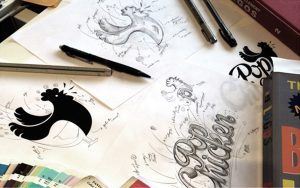Logo Design Process
A logo is not only a small visual representation of your organization, it is the brand identity of your company reflecting its values, norms, principles, and ethics. Your brand identity mirrors the creativity behind your business.
The process of logo designing is an innovative process in which a lot of time, effort, focus, and imagination goes into it. Understanding, analysis, research, and brainstorming combine to design a logo which is the most appropriate for your brand.
A strategic process goes behind a successful and memorable logo design that etches into the viewer’s memory in the very first look. No matter the type of the product, logo designing is a complex and creative process. Following are the steps involved in complete logo designing process.
Brief details of the logo – Listen to the requirement of the client whose logo has to be made. Clearly, understand the vision or the purpose of the logo. Ask questions. Clear all your doubts. Get all the details which you will be required by you to design the logo in the most appropriate way.

Understanding and getting a clear view of the goal of the organization behind logo making is very essential and crucial. It is very important for the logo designer to know where the logo will be used which will help him to decide the size and shape of the logo.
Also, the designer should know about the audience which the organization will target. This gives him a great help in designing according to the taste of the viewer.
An elegant and sleek approach will be preferred for a contemporary crowd while an organic design is used for attracting a not so urban crowd.
If redesigning has to be done become aware of the things which need to be changed. Pen down everything in order to refer while designing logos.It is very important to know the vision behind logo designing. This will help the logo designer to design a better logo keeping in mind all the requirements and objectives of the business.
Research– Once you have received all the relevant information necessary for designing the logo, start doing research work. Analyze everything about the purpose of logo making. Shift and broaden your way of thinking.

Take into account the purpose, the demographic region and the targeted audience for which the logo will be made. Consider all these things and fetch information related to these which will help him to design a better and most suitable logo.
Study the market. Know about the latest trends prevailing in the market for that particular industry for which the logo is being made.
Get inspiration and do brainstorming– Designers often refer to other designer’s work for inspiration. Study their designs but do not copy them. Try to understand the concept behind their creativity and their point of thinking or approach used for logo making. Get ideas and try to come up with something that is simple, elegant and effective.
![]()
Brainstorming gives you an opportunity to share your ideas with your colleagues. Know their point of view about your ideas and try to implement it in your logo to design a better logo.
Concept building– Concept is the major part of the logo. It is the concept which mirrors your potential and purpose. Different designers have different ways of thinking and approaching. A creative mind is involved behind a conceptual logo.

Once you have the concept in mind, sketch it on paper so that you can view the logo from every angle and from every point of view. Examine the logo according to the targeted audience, purpose, concept and business objective. When satisfied, move ahead with the mock-ups.
Build mock- ups– Convert the sketches you have drawn on paper to the digital form. You will begin to see the original visual appearance of the logo. Things will start coming into reality.
The logo may be textual (text based), iconic(icon based) or a blend of graphics and text. Start selecting colors which will best define the purpose and use of the logo. Try different color combinations.
Consider all the minute details while selecting colors to come up with a distinct and effective color combination.
The brand is remembered by its brand identity which has the brand name in it. Select easily readable and convincing font styles. Serif fonts are usually preferred for those logos where a modern look is required. Font choices play a vital role in enhancing the visual appearance of the logo design.
Use elements in the logo that merge well with the graphics, colors, fonts and the purpose of the logo. However, do not include too many elements in the logo which makes it too complex and heavy. A simple and sleek logo has the power of attracting more customers.

Feedback from customers– Send the client the mockups prepared. 3-4 mockups depending on the designer is generally given to the client each with different concept, color scheme and fonts used.
Get to know if there are any changes provided by the client. Sometimes the brand owners do not have much knowledge about logo designing. Make them understand the reason behind each color, font and element used in the logo for better perception. Still, if the error persists, make changes.
Make revision– Depending on the review and feedback of the client, make revisions. Understand the customer’s requirement and the changes he has mentioned and make accordingly.
If there is a problem with the conceptualization, take in more ideas, do some more research and shift your point of thinking. In case there is some color combination mistakes, switch to different color combinations which the client may have mentioned to you. Make these minor changes and design the final revised logo.
Deliver to the client– Check yourself the changes made considering the requirement of the client. Put forward your final revised logo and get it verified by the client.



Leave a Reply
Want to join the discussion?Feel free to contribute!